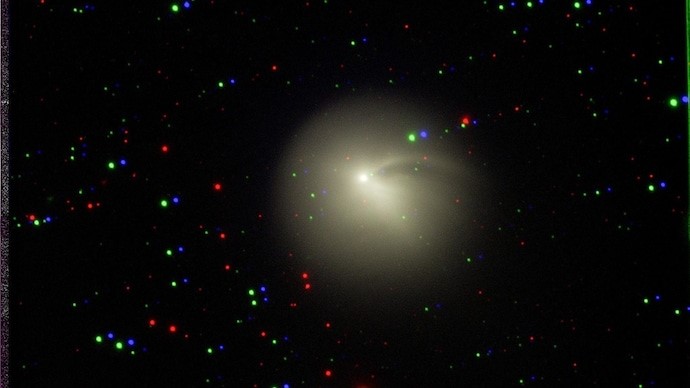Description

Disclaimer: Copyright infringement not intended.
Context
- Astronomers from IIA utilized the Himalayan Chandra Telescope (HCT) to observe Comet P12/Pons-Brooks from the Indian Astronomical Observatory in Hanle, Ladakh.
Details
- It has been playfully nicknamed the 'Devil Comet' or likened to the 'Millennium Falcon' for its distinctive appearance.
About
- Comet P12/Pons-Brooks was first discovered in 1812 and completes an orbit around the Sun every 71 years.
- Recent observations indicate remarkable activity, marked by multiple outbursts of gas and dust, significantly enhancing its brightness.
- A composite image was created from individual exposures taken with three different color filters using the HCT.
- Notable features include a bright arc from the comet's coma and a dark lane, representing the shadow of the comet's nucleus on surrounding gas.
- The comet's atmosphere appears as a spherical halo, spanning an impressive diameter of 3,50,000 kilometers, highlighting its dynamic nature.
Future Encounters
- Comet P12/Pons-Brooks is expected to have its closest encounter with the Sun on April 21, 2024, and its nearest approach to Earth on June 2, 2024.
- At its closest, it will be approximately 1.5 times the Earth-Sun distance, potentially visible to the naked eye or through basic observation tools.

About the telescope
- The Himalayan Chandra Telescope (HCT) is a notable 2-meter aperture optical-infrared telescope situated at the Indian Astronomical Observatory (IAO) in Hanle, Ladakh, India.
Overview:
- Manufacturer: Manufactured by EOS Technologies Inc., Tuscon, Arizona, USA.
- First Light: Achieved on September 26, 2000.
- Commencement of Science Observations: Operational for science observations starting May 2003.
Technical Specifications:
- Aperture:01 meters
- Mirror Material: Ultra-Low Expansion (ULE)
- Optics: Ritchey-Chretien
Instrumentation:
- Three scientific instruments mounted on an instrument mount cube at the Cassegrain focus of the telescope.
- Himalaya Faint Object Spectrograph (HFOSC)
- Near-IR Imager
- Optical CCD Imager
- Mount Cube Features: Four side ports and an on-axis port, allowing the mounting of all three instruments simultaneously.
Operation:
- Remote Operation: The telescope is remotely operated from CREST, Hosakote, via a dedicated satellite link.
- Observational Capabilities: The HCT offers optical and infrared observations, supporting various scientific studies and research endeavors in astronomy.
.jpg)
Conclusion
The Himalayan Chandra Telescope, with its impressive specifications, advanced instruments, and precision in observational capabilities, stands as a significant asset for astronomical research and observational studies. Its remote operation capability and efficient instrumentation contribute to a wide array of scientific studies in optical and infrared astronomy.
|
PRACTICE QUESTION
Q. Which part of a comet develops as it approaches the sun, forming a bright cloud-like structure?
A) Nucleus
B) Tail
C) Coma
D) Meteoroid
Answer: C)
|
















